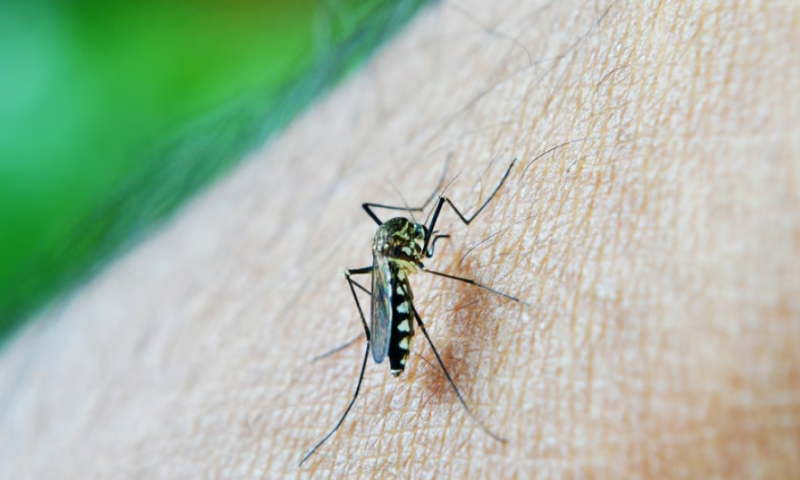After nearly four decades of development, the world finally has a malaria vaccine. The first large-scale rollout of GlaxoSmithKline’s RTS,S, or Mosquirix, kicked off at the end of November.
And more are on the way. In September, University of Oxford researchers reported promising phase 2 results for R21/Matrix-M, which bumps up the efficacy rate against infection from Mosquinix’s 35% to as high as 80%. COVID-19 vaccine-maker BioNTech is working on its own version, too.
But Mosquirix and R21 are designed only to prevent infection by the parasite that causes malaria—not transmission between infected people and uninfected mosquitoes, a key step that many scientists believe will be key to ultimately eradicating the disease entirely. Now, scientists from George Washington University in Washington, D.C. used mRNA to build a two-part vaccine set that, in mice, appears to do both. In a paper published Dec. 1 in npj Vaccines, the researchers announced that their candidates boasted a 95% efficacy rate against transmission and were nearly 80% effective against infection in the rodent models.
“An approach based on this combination vaccine can really aid in the goal of malaria elimination, which has to be the real goal—not only to control infection but also to eliminate the disease,” Nirbhay Kumar, Ph.D., co-senior author, told Fierce Biotech Research.
While non-biomedical solutions have eradicated the disease in many countries, about half the world’s population is still at risk. Outbreaks still kill more than 600,000 people every year. And while much progress was made in the early 2000s, the last few years have seen a backslide. Since 2020, cases increased by about 6%, while deaths jumped 8%, according to the WHO.
“Clearly we are seeing a negative trend,” Kumar said. While resource diversion to fight COVID-19 is partly to blame, the parasites that are passed from mosquitoes to people are also developing resistance to the first-line drugs used to treat the infection.
“We really need to do something to control and prevent these infections, and vaccines of course will be of tremendous importance,” he added.
Like the Mosquirix and R21 vaccines, the set Kumar’s team developed targets Plasmodium falciparum, the deadliest of the four parasite species that cause malaria. But while the others target a single protein that the parasite secretes as it moves through a host’s bloodstream, the new vaccines target two: one involved with helping the parasite navigate to the liver and another that helps it reproduce inside the mosquito itself.
But wait—why would an antibody in person’s blood stop parasite reproduction in a mosquito? Put simply, it comes down to mosquitoes being bloodsuckers. When a mosquito carrying the parasites bites a person, the parasites enter the liver cells, make their way to the bloodstream, multiply asexually and continue their lifecycle. A small percentage develop into sexual stages, also known as male and female gametocytes.
Then, an uninfected mosquito could come along and drink the blood of that same person (scientists call it a “blood meal”), taking in the gametocytes as part of its dinner. The gametocytes reproduce inside the mosquito, which then transfers their offspring into the next person when it’s time for another blood meal—and the cycle continues.
“Infected mosquitoes infect people, and infected people then transmit those parasites back to the mosquitoes,” Kumar explained. “What we are trying to do is basically stop and intervene in both of those aspects—that is, to stop the infection by mosquitoes and to stop the transmission to the mosquitoes so that [the vaccine] can be an effective tool.”
The protein that is targeted to prevent transmission, Pfs25, has been on scientists’ radars for some time. But getting hosts to generate an immune response against it proved challenging for many reasons. mRNA technology changed that, Kumar said.
“We had a good target. It was just a question of having the right vaccine platform that can mimic the structure of the proteins or antigens in the parasites so it can be functionally effective,” he explained. “The mRNA platform has shown tremendous potential—I mean, we have actually been floored by the data that we got in our own studies.”
The two shots in the set are designed to work together or on their own, but the researchers are confident that they’ll both be needed for best results. They’ll also likely require multiple doses. In the study, the transmission-blocking vaccine was able to achieve greater than 95% efficacy with as few as two doses, but three to four doses of the infection-prevention vaccine were required to reach roughly 80% efficacy. This is on par with the other malaria vaccines in use; the Mosquinix primary series is four doses, while R21’s include three.
Kumar and co-senior author Drew Weissman, M.D., Ph.D.—a University of Pennsylvania researcher who pioneered the technology that became part of the COVID-19 vaccines—filed a patent application for the malaria vaccines. Further research will be required to understand optimal dosing and how long protection holds up; the team plans to follow mice in the next experiments for at least nine months, roughly a third of their lifespans. They also hope to study the vaccines in baboons and other primates as well as develop mRNA vaccines against other malaria-causing parasitic strains.
“There are equally important parasite species…that are very common and cause co-infections with P. falciparum,” Kumar explained. “If we’re talking about malaria elimination, targeting P. falciparum will not be enough.”

